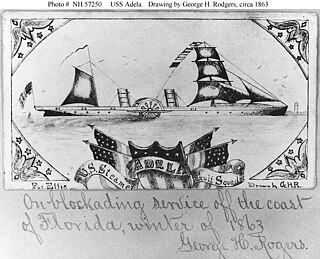
The 1st Confederate States Congress, consisting of the Confederate States Senate and the Confederate States House of Representatives, met from February 18, 1862, to February 17, 1864, during the first two years of Jefferson Davis's presidency, at the Virginia State Capitol in Richmond, Virginia.

The 2nd Confederate States Congress, consisting of the Confederate States Senate and the Confederate States House of Representatives, met from May 2, 1864, to March 18, 1865, during the last year of Jefferson Davis's presidency, at the Virginia State Capitol in Richmond, Virginia. Its members were elected in the 1863 congressional elections.

The Adelidae or fairy longhorn moths are a family of monotrysian moths in the lepidopteran infraorder Heteroneura. The family was first described by Charles Théophile Bruand d'Uzelle in 1851. Most species have at least partially metallic patterns coloration and are diurnal, sometimes swarming around the tips of branches with an undulating flight. Others are crepuscular and have a drab coloration. Fairy longhorn moths have a wingspan of 4–28 millimeters, and males often have especially long antennae, 1–3 times as long as the forewing.

USS Adela (1862) was a steamer captured by the Union Navy during the American Civil War. She was used by the Union Navy as a gunboat in support of the Union Navy blockade of Confederate waterways.
Caristanius decoloralis is a moth of the family Pyralidae described by Francis Walker in 1863. It is native to North America, where it has been recorded from North Carolina, Florida and eastern Texas. It is an introduced species in Hawaii.

Adela is a genus of the fairy longhorn moth family (Adelidae). Among these, it belongs to subfamily Adelinae.
Adela purpurea is a moth of the family Adelidae or fairy longhorn moths. It was described by Francis Walker in 1863. It is widespread in boreal North America, from the Yukon through the southern provinces of Canada to Quebec and further south to northern New Jersey.
Adela ridingsella, Ridings' fairy moth, is a moth of the Adelidae family or fairy longhorn moths. It was described by James Brackenridge Clemens in 1864. It is widespread in eastern North America, from Nova Scotia, Ontario, Quebec and Maine to Pennsylvania and the mountains of North Carolina.
Omphalocera cariosa is a species of snout moth, and the type species in the genus Omphalocera. It was described by Julius Lederer in 1863. It is found from North America to Brazil.
Fissicrambus fissiradiellus is a moth in the family Crambidae. It was described by Francis Walker in 1863.

Lipocosma sicalis is a moth in the family Crambidae. It was described by Francis Walker in 1859. It is found in North America, where it has been recorded from Alabama, Arkansas, Florida, Georgia, Illinois, Indiana, Kansas, Maryland, Massachusetts, Mississippi, Missouri, New Hampshire, North Carolina, Ohio, Oklahoma, Ontario, South Carolina, Tennessee, Texas and West Virginia.

Crocidophora tuberculalis, the pale-winged crocidiphora moth, is a moth in the family Crambidae. It was described by Julius Lederer in 1863. It is found in North America, where it has been recorded from Alabama, Florida, Georgia, Illinois, Indiana, Maine, Maryland, Massachusetts, Mississippi, New Hampshire, North Carolina, Ohio, Oklahoma, Ontario, Quebec, South Carolina, Tennessee, Texas, Virginia, West Virginia and Wisconsin.
Rupela tinctella is a moth in the family Crambidae. It was described by Francis Walker in 1863. It is found in Florida, Georgia, Louisiana, Mississippi, North Carolina, South Carolina, Texas, Mexico, Cuba, the Guianas, Trinidad, Brazil (Paraná), Paraguay and northern Argentina.
Diathrausta reconditalis, the recondite webworm moth, is a moth in the family Crambidae. It was described by Francis Walker in 1859. It is found in North America, where it has been recorded from Alabama, Arizona, Florida, Indiana, Kentucky, Maryland, Massachusetts, Mississippi, New Hampshire, New York, North Carolina, Ohio, Oklahoma, Ontario, South Carolina, Tennessee and West Virginia.

Glyphodes pyloalis, the lesser mulberry snout moth, lesser mulberry pyralid or beautiful glyphodes moth, is a moth in the family Crambidae. It was described by Francis Walker in 1859. It is found in Iran, China, Japan, India, Indonesia (Sumatra), Sri Lanka, Taiwan, the Democratic Republic of the Congo, Equatorial Guinea, Mozambique and North America, where it has been recorded from Florida, Maryland, North Carolina, South Carolina and Virginia.

Dichorda iridaria, the showy emerald moth, is a moth of the family Geometridae. The species was first described by Achille Guenée in 1857. It is found in North America, where it has been recorded from Alabama, Arkansas, Florida, Georgia, Illinois, Indiana, Iowa, Kentucky, Maryland, Massachusetts, Mississippi, New Hampshire, New Jersey, New York, North Carolina, Ohio, Oklahoma, Ontario, Pennsylvania, Quebec, South Carolina, Tennessee, Texas, Virginia, West Virginia and Wisconsin.

Herpetogramma theseusalis is a moth in the family Crambidae. It was described by Francis Walker in 1859. It is found in North America, where it has been recorded from Alabama, Florida, Maine, Maryland, North Carolina, Quebec, South Carolina, Texas and Virginia.

Antaeotricha albulella, the vestal moth, is a moth in the family Depressariidae. It was described by Francis Walker in 1864. It is found in the United States where it has been recorded from Alabama, Florida, Georgia, Louisiana, Maryland, Mississippi, New Jersey, North Carolina, Oklahoma, South Carolina, Texas and West Virginia.
Anacampsis conclusella is a moth of the family Gelechiidae. It was described by Francis Walker in 1864. It is found in North America, where it has been recorded from Alabama, Alberta, Florida, Illinois, Indiana, Kentucky, Louisiana, Maine, Maryland, Mississippi, New York, North Carolina, Ohio, Oklahoma, Pennsylvania, South Carolina, Tennessee, Texas and West Virginia.










